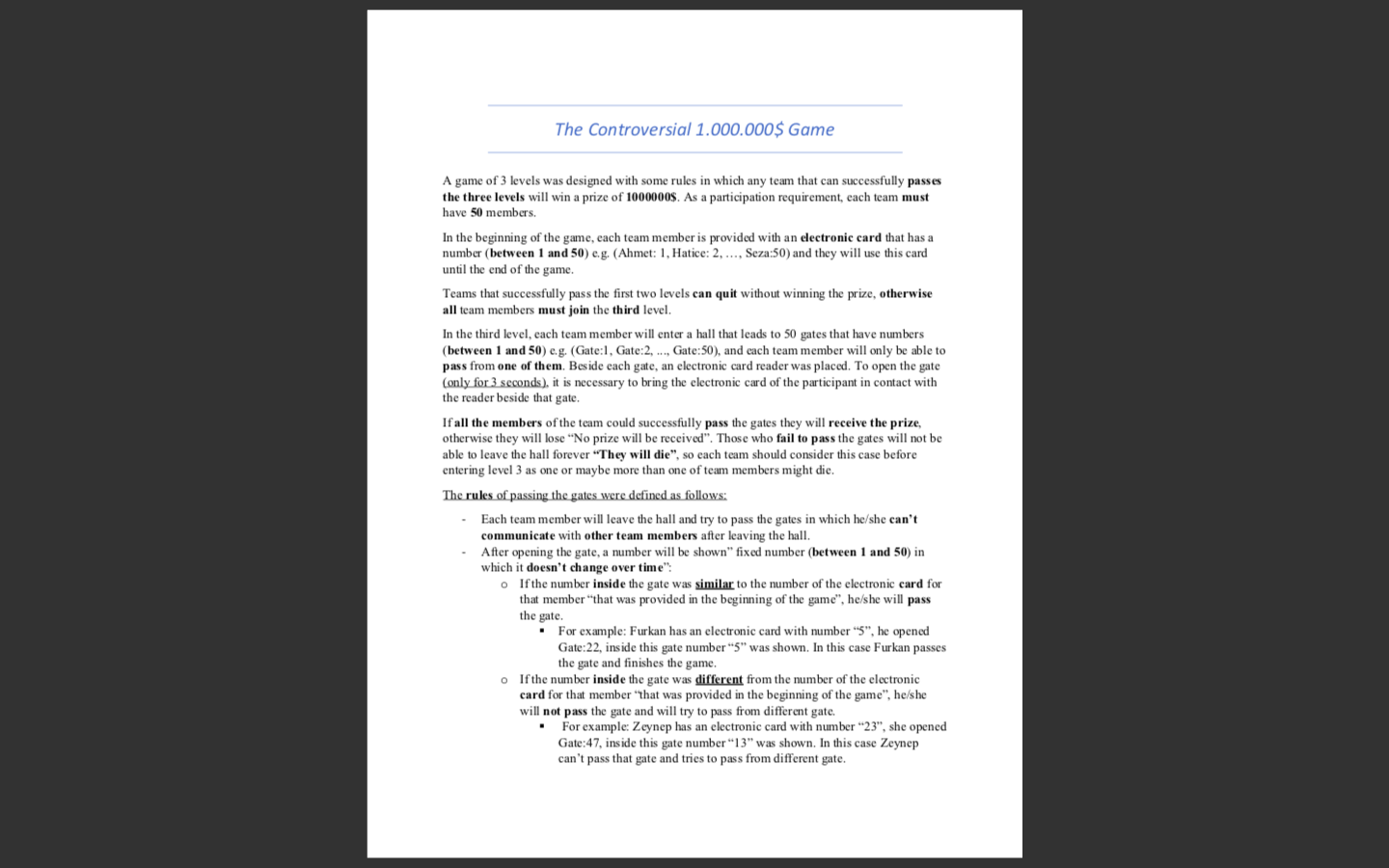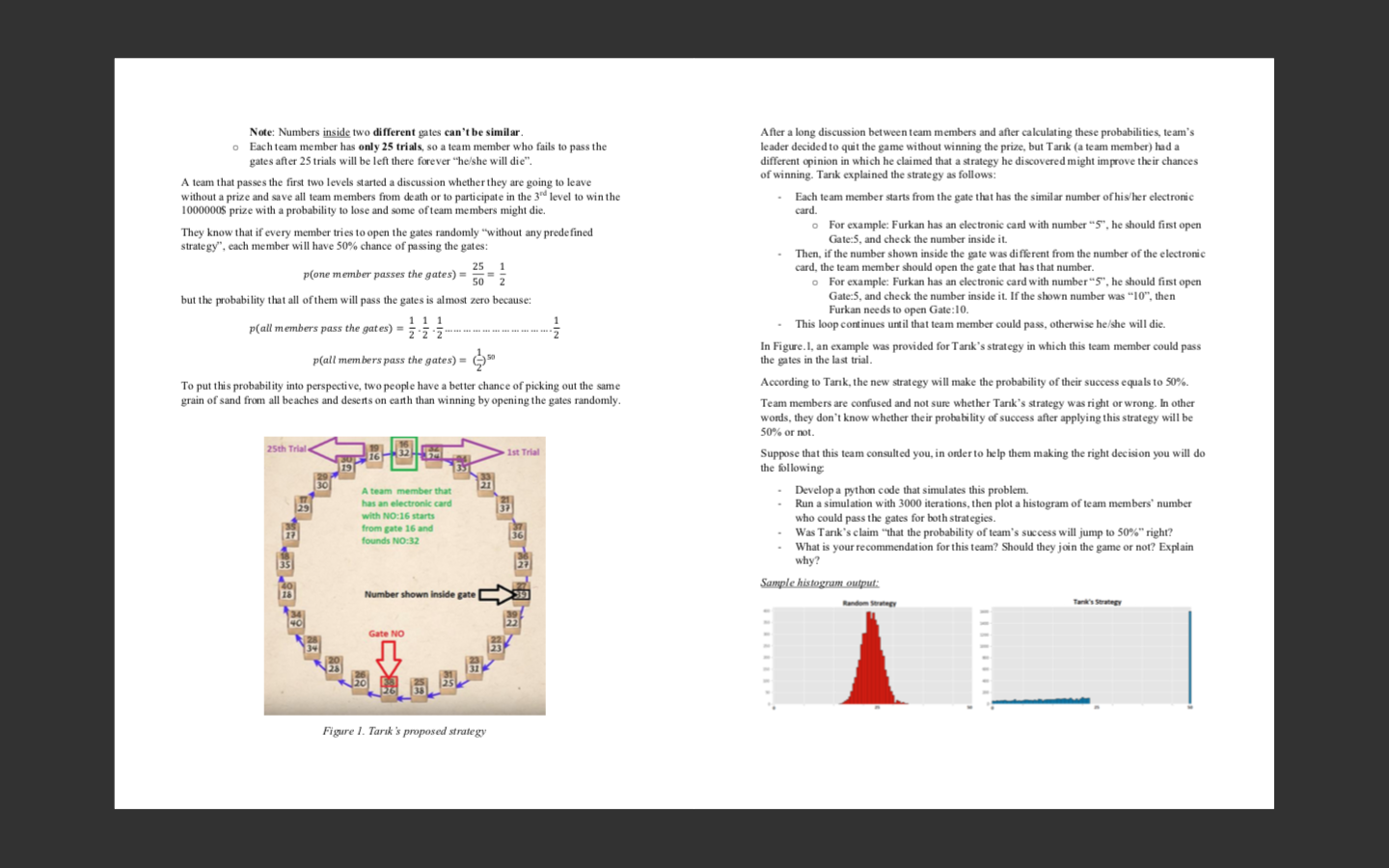

A game of 3 levels was designed with some rules in which any team that can successfully passes the three levels will win a prize of 1000000s. As a participation requirement, each team must have 50 members. In the beginning of the game, each team member is provided with an electronic card that has a number (between 1 and 50) e.g. (Ahmet: 1, Hatice: 2, ..., Seza:50) and they will use this card until the end of the game. Teams that successfully pass the first two levels can quit without winning the prize, otherwise all team members must join the third level. In the third level, each team member will enter a hall that leads to 50 gates that have numbers (between 1 and 50) e.g. (Gate:1, Gate:2,.., Gate: 50 ), and each team member will only be able to pass from one of them. Beside each gate, an electronic card reader was placed. To open the gate (only for 3 scconds), it is necessary to bring the electronic card of the participant in contact with the reader beside that gate. If all the members of the team could successfully pass the gates they will receive the prize, otherwise they will lose "No prize will be received". Those who fail to pass the gates will not be able to leave the hall forever "They will die", so each team should consider this case before entering level 3 as one or maybe more than one of team members might die. The rules of passing the gates were defined as follows: - Each team member will leave the hall and try to pass the gates in which he/she can't communicate with other team members after leaving the hall. - After opening the gate, a number will be shown" fixed number (between 1 and 50 ) in which it doesn't change over time": If the number inside the gate was similar to the number of the electronic card for that member "that was provided in the beginning of the game", he/she will pass the gate. - For example: Furkan has an electronic card with number " 5 ", he opened Gate:22, inside this gate number "5" was shown. In this case Furkan passes the gate and finishes the game. If the number inside the gate was different from the number of the electronic card for that member "that was provided in the beginning of the game", he/she will not pass the gate and will try to pass from different gate. - For example: Zcynep has an electronic card with number "23", she opened Gate:47, inside this gate number "13" was shown. In this case Zeynep can't pass that gate and tries to pass from different gate. Note: Numbers inside two different gates can't be similar. After a long discussion between team members and after calculating these probabilities, team's o Each team member has only 25 trials, so a team member who fails to pass the leader decided to quit the game without winning the prize, but Tark (a team member) had a gates after 25 trials will be left there forever "he/she will die". different opinion in which he claimed that a strategy he discovered might improve their chances A team that passes the first two levels started a discussion whether they are going to leave of winning. Tark explained the strategy as follows: without a prize and save all team members from death or to participate in the 3nd level to win the 10000005 prize with a probability to lose and some of team members might die. - Each team member starts from the gate that has the similar number of hisher electronic card. They know that if every member tries to open the gates randomly "without any predefined - For example: Furkan has an electronic card with number "5", he should first open strategy", each member will have 50% chance of passing the gates: Gate:5, and check the number inside it. p(onememberpassesthegates)=5025=21 - Then, if the number shown inside the gate was different from the number of the electronic card, the team member should open the gate that has that number. but the probability that all of them will pass the gates is almost zero because: For example: Furkan has an electronic card with number " 5 ", he should first open Gate:5, and check the number inside it. If the shown number was " 10, then p(allmemberspassthegates)=21212121 Furkan needs to open Gate:10. p(allmemberspassthegates)=(21)50 - This loop continues until that team member could pass, otherwise he/she will die. In Figure.1, an example was provided for Tark's strategy in which this team member could pass the gates in the last trial. To put this probability into perspective, two people have a better chance of picking out the same According to Tark, the new strategy will make the probability of their success equals to 50%. grain of sand from all beaches and deserts on earth than winning by opening the gates randomly. Team members are confused and not sure whether Tarik's strategy was right or wrong. In other words, they don't know whether their probability of success after applying this strategy will be 50% or not. Suppose that this team consulted you, in order to help them making the right decision you will do the following - Develop a python code that simulates this problem. - Run a simulation with 3000 iterations, then plot a histogram of team members' number who could pass the gates for both strategies. - Was Tark's claim "that the probability of team's success will jump to 50% " right? - What is your recommendation for this team? Should they join the game or not? Explain why? Sample histogram output: rigure 1. taris s proposea srraregy








